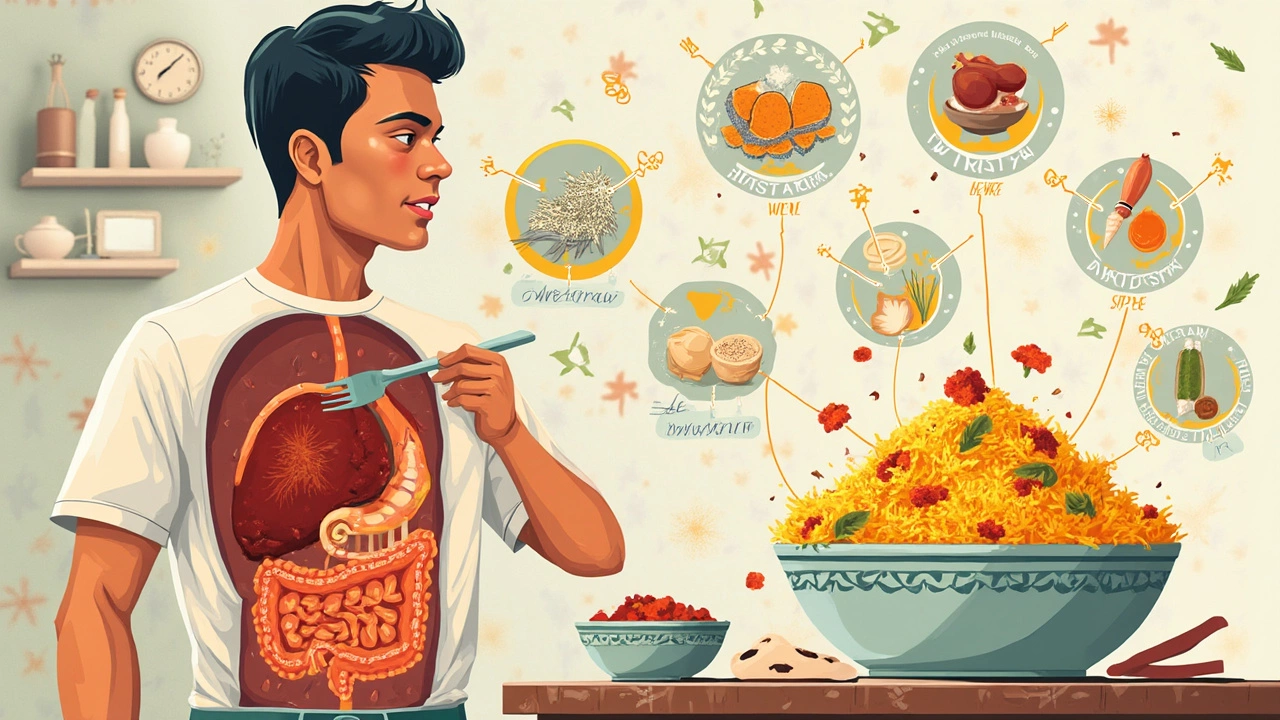Ever noticed how a plate of biryani can leave you full, happy, and sometimes a little too sleepy? It's not just about delicious flavors—biryani actually does a lot behind the scenes in your body. You’ve got meat, rice, spices, oil, and sometimes even nuts and raisins mixed together in one dish. It's a combo that packs a punch both for your taste buds and your system.
Biryani is calorie-dense, so even a small serving can make a big dent in your daily energy needs. The basmati rice gives you fast carbs, while the meat—whether it’s chicken, lamb, or goat—is loaded with protein and fat. Then there’s all the spices: turmeric, cumin, cardamom, and more. These aren’t just there for taste—they trigger all sorts of reactions in your gut and even have anti-inflammatory perks. But—not all biryanis are created equal. Some recipes load up on ghee or oils, and that can make a difference in how you feel and how your body processes the meal.
If you love biryani and want to keep enjoying it—without the food coma or health guilt—you’re in the right place. Let’s break down what exactly each part of biryani does for your body, and what you can tweak for your next meal so Luna (my cat) won’t be the only one feeling energetic after dinner.
- Biryani Ingredients: What's Really in That Plate?
- Immediate Reactions: Digestion and Energy
- Long-term Effects: Is Biryani Good for You?
- How to Make Biryani Healthier Without Losing Flavor
Biryani Ingredients: What's Really in That Plate?
Biryani isn’t just rice and meat tossed together. There’s a reason it tastes so good and keeps you feeling full for hours. Understanding your plate goes way beyond counting calories—it’s about knowing what each ingredient brings to the table.
First up, there’s basmati rice. This long-grain rice is lower on the glycemic index than regular white rice, so it won’t spike your blood sugar as fast. Still, it’s pure carbs—about 70% of a standard biryani portion is just rice. If you’re counting calories or carbs, keep this in mind.
Then come the proteins. Chicken and mutton are the go-tos for most folks. Both are high in protein and iron, but mutton packs more fat, especially the saturated kind. Chicken is a lighter option for those trying to cut back on heavier fats. If you’re vegetarian, you might see biryanis with paneer or vegetables, which swaps animal protein for plant-based stuff but keeps the calories similar because of oil and dairy.
The rich taste comes from the fat. Ghee (clarified butter), vegetable oil, or sometimes even cream, gets mixed in. Ghee gives biryani its signature aroma but is high in cholesterol. If you want to lighten it up, try using less oil or swap in olive oil. Trust me, you still get good flavor without swimming in extra calories.
Biryani isn’t just about the big stuff though. The flavor blast is all about the spices—turmeric, cumin, coriander, cinnamon, and cardamom. These are not just there for taste; they’re packed with antioxidants. Turmeric, for example, has curcumin, which is linked to reducing inflammation. Spices like black pepper help you absorb more nutrients from the other ingredients.
- Biryani is usually layered with fried onions, which add crunch and flavor, but they also bring in more oil and sugar from the caramelization process.
- Nuts and raisins show up in some biryanis, adding crunch and a touch of sweetness. Raisins bump up the natural sugar, while nuts like cashews throw in healthy fats—but also extra calories.
- Yogurt is often used in the marinade. It makes the meat tender and adds gut-friendly bacteria. Plus, it has calcium for your bones.
Here’s how chef Kunal Kapur sums it up:
"Every ingredient in biryani matters. The balance of rice, protein, fat, and spice isn’t just about tradition—it changes the dish’s whole impact on your body."
Once you know what’s inside your biryani, you can make better choices—like swapping out fats, adding more veggies, or balancing your plate with sides. That way, you get the taste, but not the food hangover.
Immediate Reactions: Digestion and Energy
This is where biryani gets real—right after you take that first bite. Your body gets hit with a surge of carbs thanks to the rice, and this means your blood sugar jumps up pretty fast. That’s why you might feel an energy boost, but sometimes you’re also sluggish a little later. It’s kind of like the classic post-pasta nap, but with more spice and flavor.
Now, the meat in biryani (like chicken or mutton) is not just about taste—it sticks around in your stomach longer because protein and fat take more time to break down. This slow digestion is why biryani feels so filling, but it’s also what sometimes causes that “heavy” feeling after a big plate. Add in oily or ghee-heavy recipes and your digestion can get a little more sluggish.
- Spices like ginger, cumin, and black pepper can actually help your gut by kicking your digestive enzymes into gear. That’s nature’s way of helping you digest something rich.
- Saffron and cardamom are good for fighting bloating and gas, so they don’t just taste fancy—they do some work for your stomach, too.
- If your digestive system is on the sensitive side, spicy or very greasy biryani can cause acid reflux or heartburn. It really depends on how your own body reacts to rich foods.
“Meals rich in refined grains and fats, such as biryani, often cause a rapid spike in blood glucose and may lead to an energy slump afterward,” says Dr. Santosh Varma, a gastroenterologist based in Hyderabad.
If you ever wondered why sometimes biryani perks you up and other times it knocks you out, it’s this combo. Sugary rice gives you a quick lift, while protein and fat slow your system down. For people with diabetes or those watching their health, portion size and recipe tweaks can make all the difference. Drinking water, adding yogurt raita, and not lying down right after eating—these are easy ways to help your stomach handle the feast a bit better.

Long-term Effects: Is Biryani Good for You?
Eating biryani every now and then isn't a big deal, but if it's your go-to comfort food every week, that's when your body really starts to notice. Let's get real about what regular biryani does in the long run—both good and bad.
First, let's break down what you’re actually putting in your body. Typical biryani is high in calories and fat, especially if it’s cooked with ghee, butter, or oil. That means excess calories can sneak up on you and lead to weight gain over time. And with red meat biryani, the saturated fat may bump up your cholesterol if you’re not careful. But—flip the coin, and you’ve also got a solid dose of protein from chicken or lamb, and loads of antioxidants from all those spices. Turmeric and cumin, especially, have proven benefits for your immune system and inflammation.
Here’s a quick look at what happens with regular biryani-eating:
- Biryani can cause steady weight gain if you overshoot your daily calorie needs (a chicken biryani serving easily runs 400-600 calories—often more in restaurants).
- High salt levels in restaurant or takeout biryani might nudge up your blood pressure if you’re sensitive.
- If your biryani uses lots of vegetables and lean proteins, or swaps in brown rice, you’re giving your body more fiber and micronutrients—making it a smarter choice.
- All those spices? They can help your gut, but super spicy biryani may bother some people’s stomachs over time.
- Ghee and deep-fried onions bring flavor, but add saturated fat, which isn’t great for heart health if eaten too often.
To help you see what’s happening on a practical level, check out this table comparing a typical homemade biryani with a restaurant version:
| Biryani Type | Calories (per serving) | Saturated Fat (g) | Sodium (mg) | Protein (g) |
|---|---|---|---|---|
| Homemade Chicken Biryani | 430 | 4 | 680 | 28 |
| Restaurant Chicken Biryani | 650 | 8 | 1200 | 32 |
This isn’t to scare you away from your favorite dish. It’s just about knowing what you’re eating. If you balance your biryani habit with veggies, daily exercise, and smart swaps—like using less oil or more chicken breast—it can fit into a healthy diet. But if biryani becomes your default dinner too often, chances are your waistband, cholesterol, and energy levels will notice pretty soon. Listen to your body—and maybe think about portion control the next time you reach for a second helping.
How to Make Biryani Healthier Without Losing Flavor
If you think eating biryani means giving up on healthy habits, you’re in for a surprise. Simple tweaks can keep all the taste while cutting down on the stuff you don’t want, like too much fat or salt.
Start by picking lean meats. Chicken breast or trimmed lamb have less fat than their regular versions, but still soak up the spices well. Or, try swapping out half the meat for cooked chickpeas or paneer—way more fiber and still packed with protein.
White rice is classic, but you can mix in a little brown rice or even swap some rice out with cauliflower rice. It sounds strange at first, but cauliflower rice blends right in and lowers the carb hit. If you stick to basmati, rinse it well before cooking to reduce the starch content a bit.
The oil and ghee are what really push the calories up. Most home recipes use more than needed. Just use half the amount you usually do, then add a splash of low-fat yogurt near the end to keep things moist and creamy. It tricks your taste buds into thinking you’ve used more fat than you really have.
For extra flavor without piling on salt, go heavy on the classic biryani spices—turmeric, cumin, coriander, and cardamom. Fresh ginger, garlic, mint, and cilantro seriously boost aroma and taste and have perks for digestion.
- Use lean meats or plant-based protein.
- Mix brown rice or cauliflower rice with white rice for more fiber and fewer calories.
- Cut the oil or ghee in half; swap in low-fat yogurt for moisture.
- Double down on spices and herbs so you crave less salt.
- Add veggies like carrots, peas, or spinach—they blend in and fill you up.
There’s no need to lose the magic of strong biryani flavors just to lighten things up. With these switches, your biryani will taste just as rich, and your body will thank you later.
